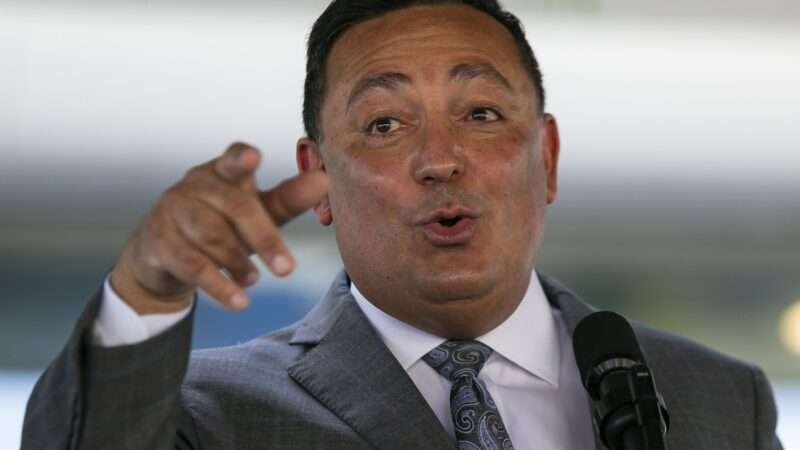Miami Mayor Francis Suarez, who just hired Art Acevedo to run that city’s police department, calls him “the best chief in America.” Given Acevedo’s record as head of the Houston Police Department (HPD), that would be a pretty sad commentary on the competence, honesty, and intelligence of the nation’s law enforcement leaders.
One person who emphatically disagrees with Suarez’s assessment is John Nicholas, whose 58-year-old sister, Rhogena Nicholas, was killed by plainclothes Houston narcotics officers in January 2019 during a no-knock drug raid based on a fraudulent search warrant. In circumstances that have yet to be fully explained, the cops also killed her 59-year-old husband, Dennis Tuttle, and the couple’s dog.
“To this day, he hasn’t fixed his own department,” John Nicholas told WFOR, the CBS station in Miami. In fact, Acevedo, who is president of the Major Cities Chiefs Association, did not seem to think his department needed fixing. Ten months after the deadly home invasion—when it was already clear that veteran narcotics officer Gerald Goines, with a colleague’s help, had falsely portrayed Rhogena Nicholas and her husband as dangerous heroin dealers—Acevedo was still dismissing “the chances of this being systemic.”
So far a dozen current or former members of the HPD’s Narcotics Squad 15, which executed the raid, have been charged with felonies as a result of the investigations prompted by the operation that killed Nicholas and Tuttle. The defendants include Goines, who faces federal civil rights charges as well as state charges of felony murder, tampering with government documents, and theft of public money; Steven Bryant, who backed up Goines’ story about a fictional heroin purchase by a nonexistent confidential informant; Felipe Gallegos, who is charged with murdering Tuttle; officers accused of claiming phony overtime pay; and supervisors charged with falsifying records.
According to news reports and court documents, Goines routinely lied to obtain no-knock search warrants, framed innocent people, handled evidence recklessly, carried on a sexual relationship with a confidential informant, and stole public money. Local prosecutors, who are reviewing cases in which Goines and Bryant were involved, say other narcotics officers were also dishonest and corrupt.
“Houston Police narcotics officers falsified documentation about drug payments to confidential informants with the support of supervisors,” Harris County District Attorney Kim Ogg said in July. “Goines and others could never have preyed on our community the way they did without the participation of their supervisors; every check and balance in place to stop this type of behavior was circumvented.”
A federal civil rights lawsuit that Nicholas’ brother and mother filed in January says Squad 15 “operated as a criminal organization” that “tormented Houston residents for years.” According to the complaint, the officers’ crimes included “search warrants obtained by perjury,” “false statements submitted to cover up the fraudulent warrants,” “improper payments to informants,” “illegal and unconstitutional invasions of homes,” “illegal arrests,” and “excessive force.”
Acevedo wants credit for not sweeping Goines’ lethal fraud under the rug. “I understand the family’s pain,” he told WFOR. “My heart goes out to them. But I think it’s important for the public to know that when everything comes out through depositions and ultimately through a trial, they’re going to know that this police chief played a role into uncovering the malfeasance and uncovering the facts in this case.”
After his officers killed Nicholas and Tuttle, however, Acevedo credulously accepted their account of what had happened. He repeatedly hailed them as “heroes,” describing Goines as “a big teddy bear” who was “tough as nails” and had “tremendous courage.” He posthumously tarred Nicholas and Tuttle as public menaces, claiming their neighbors were grateful that police had taken down a locally notorious “drug house” and “problem location.” Acevedo was “on TV calling my sister and her husband scumbags and dopers, drug dealers,” John Nicholas noted. Meanwhile, actual neighbors told local reporters they had never seen any signs of suspicious activity at the house and described the longtime residents as perfectly nice people.
Even after Goines admitted that the heroin purchase he described in his search warrant affidavit never happened, Acevedo bizarrely insisted that police “had probable cause to be there.” He said there was ample evidence to justify the raid, citing a tip from a woman who reported that her daughter “was in there doing heroin” and said “there were guns and heroin.”
Three months later, a federal grand jury charged Patricia Ann Garcia, the tipster cited by Acevedo, with making the whole thing up. Last week Garcia pleaded guilty to making false 911 calls. In other words, the investigation that Avecedo defended was based on lies from start to finish.
Acevedo still says Goines’ colleagues in Squad 15 acted in good faith based on a warrant they believed was valid and should not be held responsible for his fabrications. In January, after a Harris County grand jury indicted Gallegos for killing Tuttle, Acevedo reiterated his position that the cops “responded appropriately” to the “deadly threat” they encountered after they broke in the door and immediately opened fire, killing the dog with a shotgun.
An independent forensic examination commissioned by the Tuttle and Nicholas families cast doubt on key parts of Acevedo’s story, including the justification for shooting the dog and the claim that Nicholas, who was unarmed, posed an imminent threat. The physical evidence indicates that the cops, who said Tuttle responded to the violent invasion of his home by grabbing a revolver and shooting at the intruders, blindly and wildly fired dozens of rounds. Tuttle—who supposedly fired four rounds, hitting one cop in the shoulder, two in the face, and one in the neck—was frail and disabled, which his family says makes that feat implausible.
The Nicholas lawsuit names Acevedo as a defendant, along with the city and 13 officers who helped instigate the raid, executed it, or allowed it to happen. Acevedo “has continued to praise members of Squad 15 as ‘heroes’—other than the symbolic, conveniently sacrificed fall-men [Goines and Bryant],” the complaint says. “Acevedo professed that he ‘stands with the members of Squad 15,’ who he ‘considers victims.’ Even worse, without any legitimate evidence or basis, Acevedo claimed ‘the facts are going to come out’ to show that HPD ‘had probable cause to be there.'”
The lawsuit argues that Acevedo “ratified both the unreasonable search and the excessive deadly force utilized by Squad 15 because he (1) failed to supervise, reprimand, or take action regarding the violations prior to the raid and (2) he approved and ratified the raid, including the existence of probable cause, after the raid occurred.” By “ratifying these acts,” the complaint says, Acevedo “approved of obvious violations of clearly established law.”
The Nicholas and Tuttle families complain that Acevedo, despite his promises of transparency, has refused to answer basic questions about the raid’s genesis and execution, including what basis (if any) there was to think Tuttle and Nicholas were drug dealers, how many rounds were fired during the raid, who shot whom, and how police know that. One reason those details remain unclear: There is no body camera footage of the raid itself.
After the raid, Acevedo belatedly decided that narcotics officers should wear body cameras while executing search warrants. He also began requiring high-level approval for no-knock warrants.
While you might think “the best chief in America” would have seen the value of such precautions even before a scandal forced his hand, Acevedo portrays himself as a forward-thinking reformer. He played that role during last year’s Black Lives Matter protests, when he joined demonstrators in decrying racism and expressing outrage at George Floyd’s death, and at the 2020 Democratic National Convention, where he urged “action at the national level” to address police abuse. Acevedo’s passing of the buck to Congress was unsurprising, given the deadly corruption in his own department.
After Suarez described Acevedo as “the Tom Brady or Michael Jordan of police chiefs,” Houston Chronicle Web Editor Dan Carson offered a different take, calling Acevedo “the LeBron James of performative self-promotion.” Last summer, Carson noted, Acevedo “walked with BLM protesters and changed his Twitter avatar to an image of George Floyd while simultaneously sandbagging damning body camera footage of Houston police officers unloading bullets into the tased and dying body of 27-year-old Nicolas Chavez.” The footage “didn’t see the light of day for nearly six months—a testament to Acevedo’s broad skillset and coolness under hypocrisy.” Carson also cited Acevedo’s praise of the cops who killed Nicholas and Tuttle, his criticism of bail reforms he claimed to support, and his unsubstantiated allegation that NFL player Michael Bennett had assaulted an elderly woman.
Acevedo, who was Houston’s police chief for about four years, previously ran the Austin Police Department. A couple of months before he switched jobs, Austin City Manager Marc Ott reprimanded him for insubordination, fined him five days’ pay, and warned that his job was in jeopardy. In that case, the main issue was the complaint that Acevedo had rushed to judgment about a fatal police shooting of an unarmed black teenager named David Joseph. Acevedo fired Geoffrey Freeman, the officer who killed Joseph, a month after the shooting, saying he had violated department policy. That decision outraged the local police union, and city officials told Acevedo to stop publicly commenting on the case. His failure to do so was the official justification for the reprimand and penalty, although Ott also mentioned unspecified “operation and judgment concerns.”
Acevedo’s reaction to the deadly Houston raid suggests he learned something from that episode. Rather than taking swift action to address the rot revealed by Ogg’s investigators, he implied that the problem was limited to a couple of bad apples. He bent over backward to defend the officers who killed Nicholas and Tuttle, deeming their actions legally justified without revealing the factual basis for that conclusion. He said police had good reason to suspect the couple of selling drugs, but he did not present any evidence of that, aside from the phony tip and the fraudulent search warrant affidavit.
Acevedo promised he would “leave no stone unturned to determine the good, the bad and the ugly.” But more than two years after the raid, he has not told the public what was under those stones, and he leaves Houston without satisfactorily explaining why Nicholas and Tuttle died. Instead, he and the city have actively resisted the families’ attempts to determine the truth, fighting them in court to avoid revealing key information. In light of Acevedo’s reflexive defensiveness and stubborn obfuscation, Houston’s gain is Miami’s loss.

from Latest – Reason.com https://ift.tt/3vyoDb3
via IFTTT




